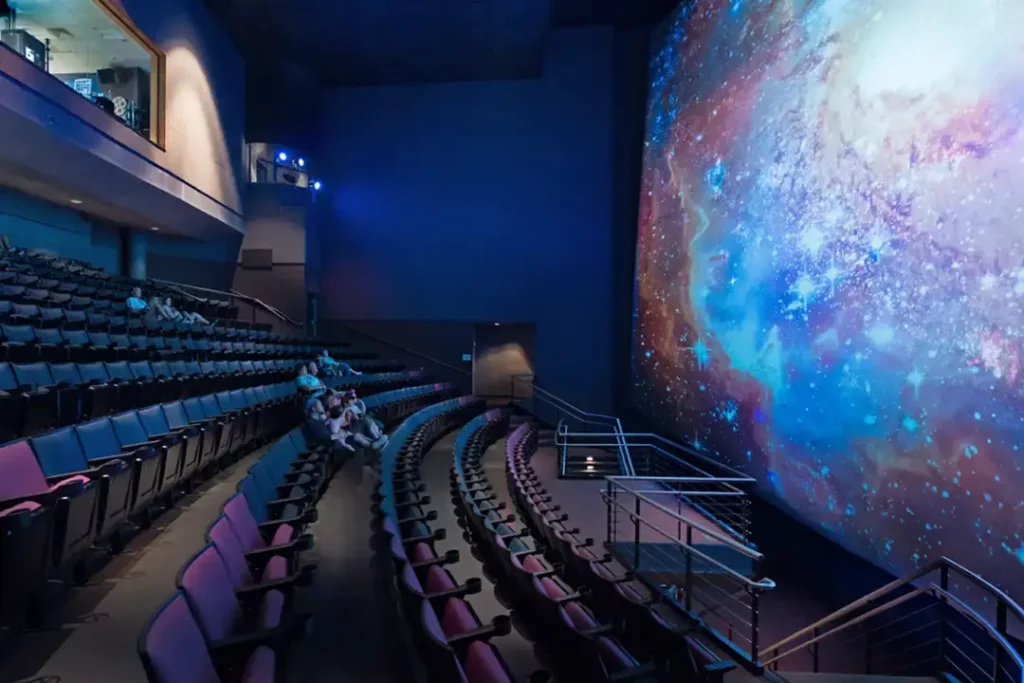
This is Brianna (she/her). And I’m Kiya Kersh (she/her). and you’re tuning into Amore360.
Today we’re discussing the sense of awe and how it relates to immersion and immersive experiences.
Let’s dive in. What is awe?
Awe is an emotion that we feel as humans when we experience something that’s larger than ourselves. So imagine you go to the Grand Canyon or you see the Pyramids. You see something that’s so large, so epic that you’re actually affected physically. Your body will affect and will be affected and will respond physically to the emotion that they’re feeling in that moment.

So maybe an IMAX screen or a work, a film or some other work that’s on an IMAX screen. Could that be considered something that would cause awe?
Definitely actually, given the size of the screen. And in fact, that’s actually something they’re really going for is to generate that sense of awe in people through their content. It’s not completely immersive, but they’re getting the IMAX screen to make it more immersive. We’re going to talk about why immersive experiences specifically generate a sense of awe and how that sense of awe can actually help you physically through lowering your stress and improving your health by affecting your vagus nerve is what we’re going to talk about.

So maybe we should get into the physiology of awe. How does the vagus nerve play a role? And we’re not saying Vegas, right? We’re saying v-a-g-u-s, right? Okay, the vagus nerve, cool.
So we have two types of nervous systems.
- We have the sympathetic nervous system, which governs fight-or-flight.
- And then we have the parasympathetic nervous system, which is what the vagus nerve governs.
So the vagus nerve is attached to the brainstem and is affected by emotion, is affected by what you see, what you hear, what you feel, and then it transmits signals to your lungs.
It affects your breathing, it affects your digestive system, It affects your heart rate.
These three things also, when they’re always creating a state of fight-or-flight, that actually is what creates a sense of stress and what is actually harmful to the body. So calming this vagus nerve is actually a really important way of reducing stress and helping your body naturally heal. So by creating relaxing situations, meditation is one way to calm the vagus nerve. And also experiencing awe has been scientifically proven to calm the vagus nerve.

What is some of this scientific research?
So in 2003, the University of Berkeley released a study on the science of awe specifically, where they surveyed about 5500 people and created scenarios to measure their heart rate and breathing. And what they found, there’s a couple of factors that they found that create a state of awe. So one of them is a sense of scale, and one I’ve mentioned before.
A sense of scale is not by itself more creative sense of awe. There also has to be what’s called a need for accommodation.
So a scale is called perceived vastness. So a need for accommodation is simply something that violates our normal understanding of the world.
So if you see something or experience something that violates that basically is so different that you have to almost restructure your brain in order to understand it. And then you add that to the perceived vastness, the sense of scale. Those two things will generate a sense of awe.
So it’s just that easy.
Yeah, I mean, it’s, that’s what they found. So it is something that we as immersive creators use this understanding in our production of experiences. So, you know, we can, we have domes now that are superior in all sayings that are very large. We also have VR experiences. We can use such a scale, we can use the need for accommodation, we can create experiences that take people out of their own world and create a violation of their normal understanding of the world. So, you know, we can create something very surreal, create something that’s very different, very strange, and that will actually create a sense of awe.
Now, why are you using this word violation? Is that the word that the researchers used?
Yeah, I don’t really agree with the best word, but scientifically, I mean, you know, something that is outside of our normal experience that is just so strange that we violate our own understanding of worlds.
So it kind of disrupts our way of seeing.
Yeah, disrupts our way of thinking and it causes us to rewire our way of thinking.
But then they also found that these experiences shift our consciousness and make us feel part of a greater whole.
So what that does is that increases empathy and immersive experiences have been found to be very important in order to create a sense of empathy because basically when you put someone inside of a projection or in VR you put someone inside of a world that their brain interprets as being real.
So a normal flat screen, when you look at a normal screen, basically you see the world around you in your peripheral vision. But if you have an immersive experience, then you see just the immersive experience, your brain starts to believe more and more that it’s actually a real experience, especially if it’s more photorealistic.
And then what that does is it basically affects us physiologically. Our heart will actually change. We’ll get goosebumps, we’ll get chills, we may have emotional releases, crying or laughing often happens when you have to be at the center of awe. And then scientists have actually found that these experiences reduce markers of the body for chronic inflammation. So this is where there’s a positive benefit for healing and wellness.
So I’m hearing disruptive scale creates awe — and awe has the potential for having these actually therapeutic experiences that are definitely beneficial.
They could be, they could be called therapeutic by medicine if they were put through clinical trials, I suppose.
But we can still benefit from these even if they’re not clinically approved, right?
Exactly.
They, the University of Southern California, actually has a whole department dedicated to studying this. There are definitely universities and researchers who are studying more and more of the clinical aspects of therapy, aspects of VR experiences, XR experiences, which also includes cognitive reality, virtual reality, and then when we talk about full dome, so dome experiences. Which also, you know, the benefit of the dome experiences, you have collective experience and there are scientists who have shown that people can raise their Oxycontin levels to be collective experiences.
I think you mean Oxytocin, not Oxycontin.
Yeah that’s a big, that’s a big difference.
Oxytocin.
Yeah.
So this is a hormone that happens through contact with groups of people, hugging someone while people do the same thing. So having a collective experience of awe is a very powerful method of raising the Oxytocin levels.

Without having touched anybody.
Exactly.
That seems pretty powerful.
The thing is, you know, I think that VR experience is a little bit more isolating, but it’s still very powerful because it’s, it’s, you’re taking people to another place, you’re taking people to another experience that takes them outside of their normal, everyday human experience. And the technology is getting better and better. The graphics are getting better, more photorealistic, frame rates are starting to get higher, which is really important.
It’s starting to lose the less technical of us, but what I’m hearing today is awe is a thing.
The vagus nerve has a role to play.
And there’s more and more science research focused on awe and the science of awe. And we in the immersive world are really interested in finding out more about science because it validates our work.
Well, and it validates what we’ve known for years, right?
Yes, exactly.
That entertainment is healthy. Entertainment has beneficial impacts for our health.
Absolutely.
So what would you like people to do now?
Check out Amore360 where you social: we are podcasting and vlogging all about immersive and talking about immersive and metaverse art, science, and business.
This is Kiya Kersh, she/her. This is Brianna Amore — and you’ve been elevating with Amore360.
Check out other videos and articles that we have available.
Thank you! Look out on YouTube for our next video.

Leave a Reply